The week at a glance
- Rufous-tailed Robin in Norfolk
- Siberian Rubythroat in Shetland
- Short-toed Eagle in Devon
- Semipalmated Plovers in Cornwall and still in Co Kerry
- Moribund Yellow-billed Cuckoo in Lancashire
- Isabelline Wheatear in East Sussex and possibles in Suffolk and Kent
- Upland Sandpiper, Wilson's Snipe and Northern Waterthrush still on Scilly
- Upland Sandpiper still in Mayo
- Black Scoter still in Northumberland
- Buff-bellied Pipit still in Shetland
- Possible Eleonora's Falcon in Lothian
The two star birds of the week were unfortunately either frustratingly brief or required a charter flight to the Northern Isles. Returning from East Hills (Norfolk) on 14th, one of the 'Punkbirders' stumbled on an annoyingly elusive mystery bird. But knowing this was something good he persisted in searching for it and 90 minutes later it finally gave itself up and showed to two observers: they were then face-to-face with Britain's third Rufous-tailed Robin. The first record was a one-day bird on Fair Isle in October 2004 and the second record was a bird found dead on North Ronaldsay (Orkney) in 2010. With clear skies forecast for overnight, the chances of this bird staying were minimal and, true to form, the 800-strong crowd the next morning went away disappointed. More would have caught up with this bird, but confusion in the excitement of the find meant that the location was first broadcast as East Hills rather than Warham Greens, hence many didn't make the move quick enough. Those twitching Warham Greens for a reported Barred Warbler were lucky enough to find something much rarer waiting for them, though!

Rufous-tailed Robin, Warham Greens, Norfolk (Photo: Rob Martin)
Rufous-tailed Robin twitch, Warham Greens, Norfolk (garybirder)
As hopes of more eastern megas increased, Shetland struck back on 19th with the finding of a male Siberian Rubythroat at Gulberwick. Apart from a suppressed bird in Durham in 2006 and one on a boat in 2005, the last four birds have all been October birds on Shetland and this remains at the top of most birders' most wanted lists. The last mainland bird was one in Dorset on this day in 1997.
After last week's Short-toed Eagle on Jersey, it isn't beyond the realms of possibility that this is the same bird that graced the southwest this week. It was first seen over Prawle Point (Devon) at midday on 16th, though wasn't reported until much later in the day. It was independently picked up over Dawlish Warren, Exmouth and Orcombe Point later in the day and was last seen over the sea at Lyme Regis mid-afternoon. With just two accepted records, neither of which have been very twitchable, this would have pleased many if it had settled.
Cornwall's excellent autumn for Nearctic waders continued, but unfortunately the Semipalmated Plover at Davidstow Airfield and Crowdy Reservoir recently for two weeks was never made public. The reasons for this seem rather bizarre considering the other news that was released from the site over the autumn. It was seen by just 15 local birders and caused a backlash both locally and nationally. Better behaved was the bird that remained at Ventry (Kerry) to at least 15th.

Semipalmated Plover, Ventry, Kerry (Photo: Derek Charles)
As is often the fate of Yellow-billed Cuckoos, one was picked up in Liverpool and taken into care on 12th, but sadly died. This is surprisingly the first record for the northwest, though there are a scattering of records from Wales and Isle of Man.
With a hint of southerly in the wind, there's always the chance of unusual wheatears turning up, and no fewer than three did (or possibly did). An Isabelline Wheatear at Crowlink (East Sussex) on 15th was a first for the county, remaining until dusk for county listers to connect but departing overnight. Other one-day birds were both possibles, at Lowestoft (Suffolk) and North Foreland (Kent), both on 13th.

Isabelline Wheatear, Crowlink NT, East Sussex (Photo: Jacob J Everitt)
In Northumberland, the drake Black Scoter remained off Goswick to 16th in the company of a drake Surf Scoter. The Upland Sandpiper continued to please all comers at Borough Farm, St Mary's (Scilly) all week, and the bird at Termoncarragh Lough (Mayo) also remained to the end of the week. There was also a third bird reported from Nosterfield LNR (North Yorks) on 16th, though this was never confirmed. Also on Scilly, the Wilson's Snipe continued to show well alongside Common Snipe at Lower Moors, St Mary's, to at least 18th and the Northern Waterthrush stuck to its routine of visiting Higgo's Project and Lower Moors, St Mary's, all week. The Buff-bellied Pipit remained at Quendale (Orkney) to 13th.
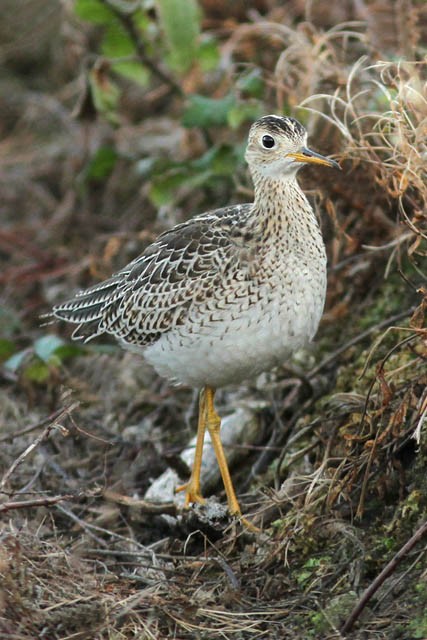
Upland Sandpiper, St. Mary's, Isles of Scilly (Photo: David H Hatton)

Wilson's Snipe, St. Mary's, Isles of Scilly (Photo: John Hague)
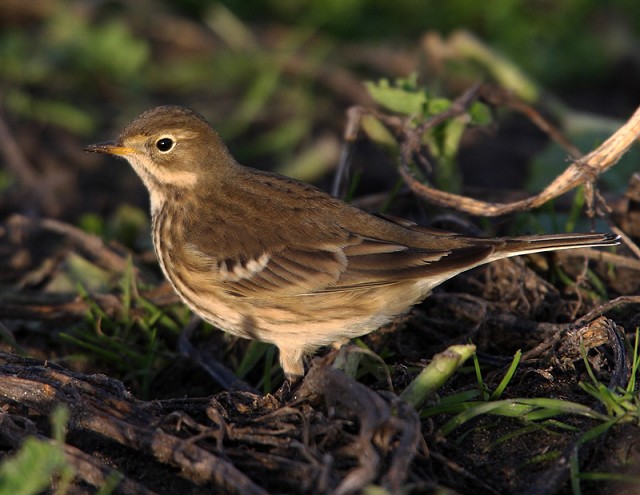
Buff-bellied Pipit, Quendale, Mainland, Shetland (Photo: James Wood)
As usual we'll end on the 'reporteds', which this week includes an Eleonora's Falcon belatedly reported from Aberlady Bay (Lothian) on 12th.
Loch Gruinart, Islay (Argyll) is once again home to an array of various vagrant geese to ponder, and this week saw three Richardson's Canada Geese, a Taverner's Canada Goose and three further 'small' Canada Geese. The four wandering Snow Geese in the northeast were at Bowesfield Marsh and nearby Saltholme (Cleveland) this week, on 15th–17th. The regular bird also remained at Craobh Haven (Argyll) to at least 16th, two were at Carrbridge (Highland) on 16th and a presumed escape was at Wicken Fen (Cambs) on 16th. Carrbridge also saw a Ross's Goose on 14th–16th and, in a wider arrival of other geese, further Ross's Geese were at Caerlaverock (Dumfries & Galloway) on 13th–19th and West Water Reservoir (Borders) on 17th. There was then an unringed first-winter Red-breasted Goose at Stanpit Marsh (Dorset) on 18th–19th, while another of more dubious origin remained at Scaling Dam Reservoir (Cleveland) to 18th. As numbers of Brent Geese increased, so further Black Brants arrived with them, with new birds at Wyke Regis and Ferrybridge (Dorset) on 13th–18th, Donna Nook (Lincs) on 17th and Stiffkey (Norfolk) on 18th. Two Ruddy Shelducks were at Coate Water (Wilts) on 16th and other singletons were at Pagham Lagoon (West Sussex) and Kedleston Park (Derbys) on 14th.

Snow Goose, Saltholme RSPB, Cleveland (Photo: Mark Newsome)

Ruddy Shelduck, Coate Water CP, Wiltshire (Photo: Graham Cox)
There were several new American Wigeon this week, in addition to the birds that remained at Wellington Gravel Pits (Herefordshire) to 16th and Loch Bee, South Uist (Outer Hebrides) to 17th. A drake at Gartnatra, Islay (Argyll) on 14th–15th was presumably the same as that at Loch Indaal on 16th, and other Scottish drakes were at Loch of Strathbeg (Aberdeenshire) on 16th–18th and at Loch of Harray (Orkney) on 16th, the latter with an impressive 31 Slavonian Grebe and 225 Scaup. Further south, another drake was at Rutland Water on 15th. In Ireland, the drake Black Duck was again reported from Achill Island (Mayo) on 16th–17th, two juvenile Blue-winged Teal were at Kilcredaun Marsh (Clare) on 15th and another juvenile was at Shannon Airport Lagoon (Clare) on 19th. The only other Blue-winged Teal was at Thorne Moors (South Yorks) on 15th.
The only Ring-necked Duck was the drake at Chew Valley Lake (Somerset) through the week, along with the resident drake Ferruginous Duck. Other 'Fudge Ducks' also remained at Lavell's Lake (Berks) to 16th and Far Ings (Lincs) to 17th, and new birds were a female at Cockshoot Broad (Norfolk) on 15th, along with a hybrid, and a drake at Castle Howard (North Yorks) on 16th. In Northumberland, the juvenile Lesser Scaup remained at Marden Quarry to 18th.
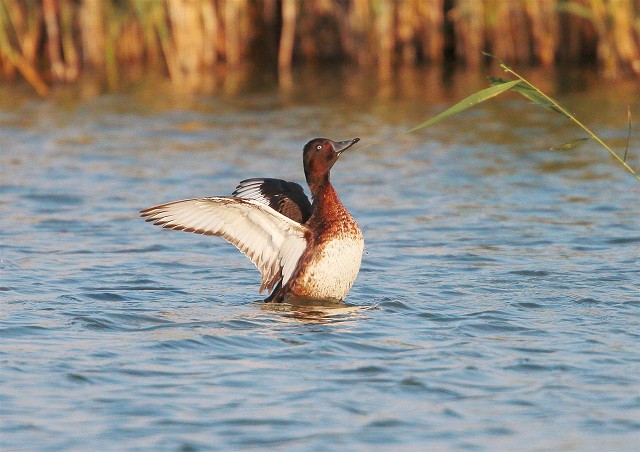
Ferruginous Duck, Far Ings NR, Lincolnshire (Photo: Howard Booty)
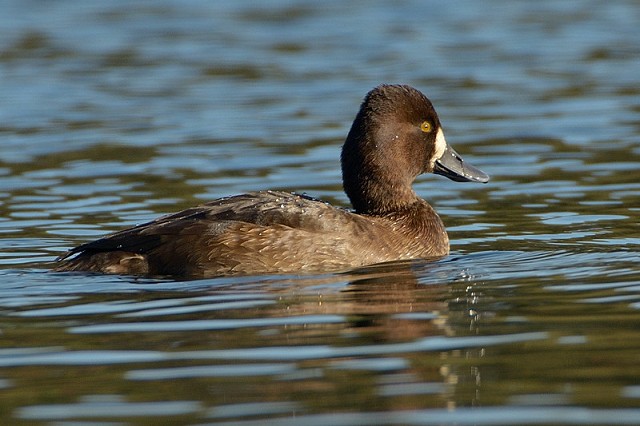
Lesser Scaup, Marden Quarry, Northumberland (Photo: Frank Golding)
On the sea, the drake Surf Scoter was again in Burghead Bay (Moray & Nairn) on 16th–18th, along with 23 Slavonian Grebes, 45 Velvet Scoters and 102 Long-tailed Ducks,. A White-billed Diver flew past Aird, Tiree (Argyll) on 18th.
Leach's Storm-petrels were reported from a small number of sites in the northwest, including three past Leasowe (Cheshire) on 18th, along with a possible Cory's Shearwater. The peak counts of Balearic Shearwater this week were just 21 past Porthgwarra (Cornwall) on 16th. There was a slight westerly bias to records of Sabine's Gull this week, with all birds being coastal. Notable counts included nine past Strumble Head (Pembrokeshire) on 7th, eight past Pendeen (Cornwall) on 6th, eight past Ramore Head (Antrim) on 7th and seven past Bridges of Ross (Clare) on 6th. Pelagic Grey Phalaropes were rather limited in number this week, reported from just nine sites across the country. Inland birds were also at Shapwick Heath (Somerset) on 13th, Gailey Reservoir (Staffs) on 14th and Grafham Water (Cambs) on 15th–19th and one also remained at Daventry Reservoir (Northants) to 18th.

Grey Phalarope, Daventry Reservoir CP, Northamptonshire (Photo: Chris Cook)
Perhaps it was the southerly airflow, but the number of Great White Egret records rocketed this week. Birds were reported from at least 29 locations, though many of these refer to wide-ranging birds. One in particular ranged far and wide in Norfolk, being seen at Titchwell on 13th, Snettisham on 16th and then Weybourne, Stiffkey, Warham Greens, Holkham Freshmarsh and Salthouse on 17th. The furthest north were birds (or more likely the same bird) at Leighton Moss (Lancs) to 17th and Kents Bank (Cumbria) on 13th–15th. Most were singletons, apart from twos at the National Wetlands Centre (Carmarthenshire), Burton Mere Wetlands (Cheshire), Seaton Marshes (Devon) and five at Ham Wall/Meare Heath (Somerset). The regular Cattle Egret was at Thorney Island (West Sussex) to 15th and one was at Burton Mere Wetlands (Cheshire) on 14th. A very elusive Squacco Heron was also at the waterbird-magnet that is Ham Wall (Somerset), seen in flight only twice on 16th. Apart from presumed Yorkshire escapees, the only White Stork was one over Symonds Yat (Glos) on 15th.
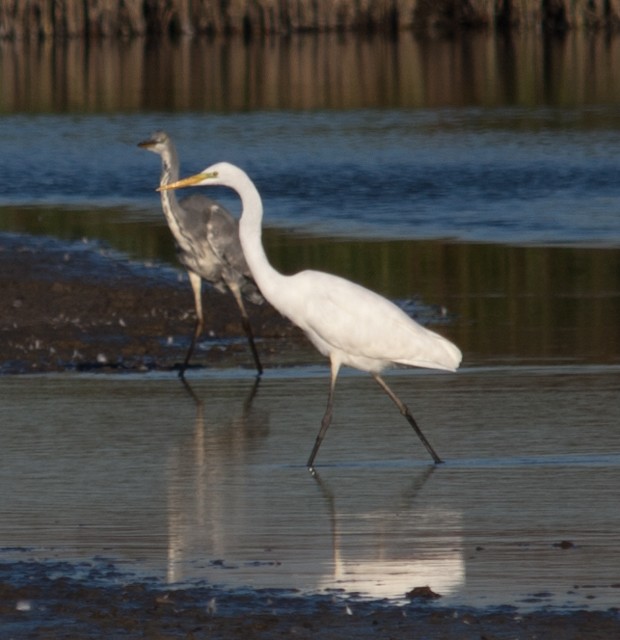
Great White Egret, Blue House Farm EWT, Essex (Photo: Thomas Harris (Aged 16))
Glossy Ibis were reported from 13 sites during the week, including new birds at Hornsea Mere (East Yorks) on 13th–14th, Bowling Green Marsh (Devon) on 14th, Saltholme (Cleveland) on 15th–18th, Eastbourne and Pett Level (East Sussex) on 18th, Bintree Mill (Norfolk) on 19th, two at Cudmore Grove (Essex) on 14th–18th and three over Ipswich (Suffolk) on 15th.
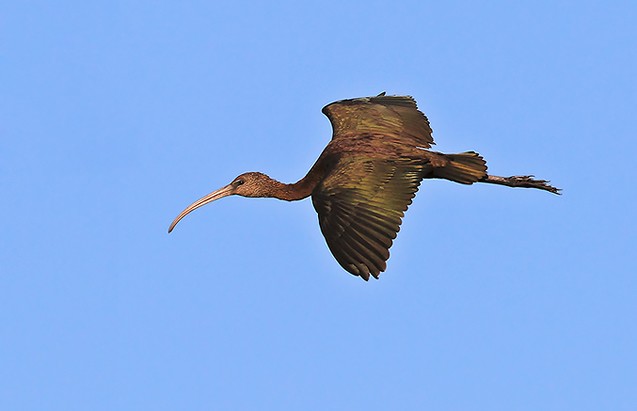
Glossy Ibis, Stanpit Marsh, Dorset (Photo: Nigel Forrow)
Glossy Ibis, Saltholme RSPB, Cleveland (Andrew Kinghorn)
Up to three Black Kites remained around Catchall (Cornwall) to 15th, with one reported on 17th. Interestingly, there were then three around St Mary's and Gugh (Scilly) from 16th–17th and these may well be the same Cornish birds relocating south. Another raptor of note was a White-tailed Eagle over Tindale Tarn (Cumbria) on 13th.

Black Kite, St. Mary's, Isles of Scilly (Photo: Martin Goodey)
Black Kites, St Mary's, Scilly (benjim1)
Pallid Harriers remained around Loch of Hillwell and Loch of Spiggie in the south of Shetland to 17th and at Wester Quarff further north on 13th. Further south, one remained at Black Down (Somerset) to 15th and another was reported from Westhay (Somerset) on 14th. In the east, one was seen briefly at Brancaster and Thornham (Norfolk) on 17th and another was reported from Tetford (Lincs) on 18th. More noteworthy, though, was a second-winter male Northern Harrier at Tacumshin (Wexford) on 15th, which had been present for as long as a week. The first main arrival of Rough-legged Buzzards occurred this week, with numerous reports, mostly from 16th. Birds were reported from 15 sites between East Yorkshire and Kent and there were also inland birds at Shawforth (Lancs) on 13th and Fen Drayton Lakes and Ouse Fen (Cambs) on 15th. In Orkney, one or more birds were recorded at four sites during the week and at the other end of the country, one was around Polgigga, Porthgwarra and Sennen (Cornwall) on 16th–18th.

Rough-legged Buzzard, Shawforth, Lancashire (Photo: Dennis)
Migrant Corncrakes were on Tresco and St Mary's (Scilly) this week and Tresco also held a Spotted Crake on 13th–14th. A probable was also flushed at Mizen Head (Cork) on 17th.

Spotted Crake, Tresco, Isles of Scilly (Photo: Dave Perrett)
Numbers of American Golden Plovers dropped somewhat this week, with birds reported from just three sites in Scotland, four in Ireland and two in England. New birds were at Whitburn (Durham) on 13th, Dursey Island (Cork) on 15th–16th and Truska (Galway) on 19th and there were two at Ballycotton (Cork) on 15th–17th, along with a Semipalmated Sandpiper. There was a late Kentish Plover this week, at Crosby (Lancs) on 14th. In the southwest, Lesser Yellowlegs remained on Tresco and St Mary's (Scilly) most of the week, and at Tresemple Pool (Cornwall) to 19th, and a new bird was at Sandaig, Tiree (Argyll) on 15th–16th. Also staying put were last week's Spotted Sandpipers; at Chew Valley Lake (Somerset) to 17th and on the Plym Estuary (Devon) to at least 19th.

Lesser Yellowlegs, St. Mary's, Isles of Scilly (Photo: Rob Hoare)
In Scotland, Long-billed Dowitchers remained at Lochlea (Ayrshire) to 17th and Caerlaverock (Dumfries & Galloway) to 13th, which may have them moved to Port Carlisle (Cumbria) on 16th–17th. One also remained at West Gerinish, South Uist (Outer Hebrides) to 14th and was then at nearby Loch Bee on 15th. The two birds that were originally at Blagdon Lake (Somerset) remained at Chew Valley Lake to 13th, before relocating back to Blagdon on 15th–19th. The only new bird was a juvenile at Tacumshin (Wexford) on 19th, with the wader-mecca also holding Least Sandpiper to 14th, a possible hudsonia Dunlin, Baird's Sandpiper and up to five Semipalmated Sandpipers and seven Buff-breasted Sandpipers during the week. The only other 'Semi-Ps' reported were singletons on Foula (Shetland) on 13th, at Ventry (Kerry) on 15th and at Ballycotton (Cork) on 16th. One at Burnham-on-Sea (Somerset) on 16th was reidentified as a worn Little Stint. On Scilly, the other Least Sandpiper also remained on Tresco to 15th.
Long-billed Dowitchers, Blagdon Lake, Somerset (megabrock161)

Semipalmated Sandpiper, Tacumshin, Wexford (Photo: Derek Charles)

Buff-breasted Sandpiper, Tacumshin, Wexford (Photo: Derek Charles)
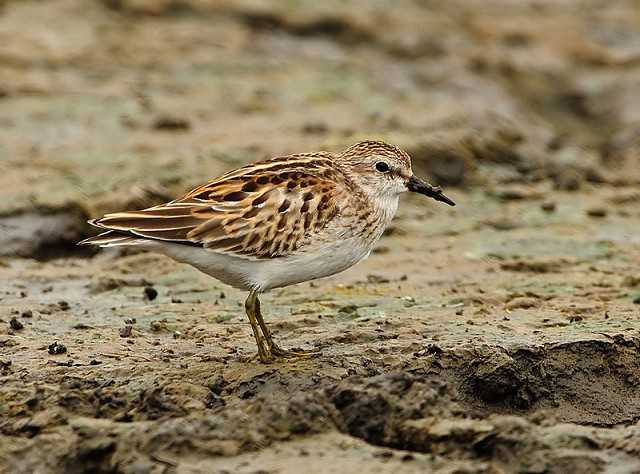
Least Sandpiper, Tresco, Isles of Scilly (Photo: Dave Perrett)
The only Temminck's Stint was at Cotswold Water Park (Wilts) on 17th. The White-rumped Sandpiper remained on Lewis (Outer Hebrides), seen at Loch Stiapavat on 15th and Eoropie on 17th. One on Achill Island (Mayo) on 13th–16th may be the bird present on 30th September, but one at Rutland Water on 15th–19th was certainly new in. Butt of Lewis also saw its Baird's Sandpiper remain to 18th, and another Outer Hebrides bird was at Carnan, South Uist on 17th.

White-rumped Sandpiper, Rutland Water, Leicestershire and Rutland (Photo: Dave Hutton)
Pectoral Sandpipers were reported from just 14 sites this week, including birds in Kent, Norfolk, North Yorkshire and Durham. Four were in western Scotland including three still at West Gerinish, South Uist (Outer Hebrides) and two at Herston, South Ronaldsay (Orkney). Away from Tacumshin, the only remaining Buff-breasted Sandpipers were singletons at Loch Sandary, North Uist (Outer Hebrides) on 13th and Achill Island (Mayo) to 15th.

Pectoral Sandpiper, St. Agnes, Isles of Scilly (Photo: Anthony Griffiths)
Small numbers of Long-tailed Skuas were reported from a few west-coast sites, peaking at six past Strumble Head (Pembrokeshire) on 18th, along with 51 Pomarine Skuas and 41 Great Skuas. In the east, birds were also recorded past Girdle Ness (Aberdeenshire) on 14th and Fife Ness on 16th. The usual Glaucous Gull remained at Dungeness (Kent) and others were singles at Loch of Spiggie (Shetland) on 13th and past Spurn (East Yorks) on 19th and a juvenile at Eoropie, Lewis (Outer Hebrides) on 17th (the last along with a juvenile Iceland Gull). Other Iceland Gulls were at Bantry (Cork) on 18th, Loch Barvas, Lewis (Outer Hebrides) on 18th and past Point of Buckquoy (Orkney) on 19th. Second-winter Ring-billed Gulls remained in Stornoway Harbour, Lewis (Outer Hebrides) to 14th, Sligo City to 18th and Cardigan (Ceredigion) to 19th and an adult was again at Stranraer (Dumfries & Galloway) on 14th. In Ireland, an adult Bonaparte's Gull was at Whitehead (Antrim) on 13th, but the reported Franklin's Gull at Schull (Cork) on 18th turned out to be a first-winter Mediterranean Gull. One returning bird was an adult Forster's Tern at Cruisetown Strand (Louth) on 13th–16th, previously seen here from 2006–09.
Also in Louth, the only Hoopoe of the week was seen over Annagassan on 18th. The southwest once again saw the lion's share of the week's Wrynecks, with birds at numerous sites in Cornwall, Scilly and south Wales. Away from here, birds were at Littlehampton (West Sussex) on 14th and Mizen Head (Cork) on 15th, and three were on Bardsey Island (Gwynedd) on 13th, two of which remained to 16th. Most records of Short-toed Larks came from the extremes, with birds at North Ronaldsay (Orkney) to 18th, on Cape Clear (Cork) to 18th and on St Mary's (Scilly) on 13th, while one was also on the Otter Estuary (Devon) on 19th.

Wryneck, Davidstow Airfield, Cornwall (Photo: Adrian Davey)
Plenty of Richard's Pipits continued to be seen (or heard), most coming from Norfolk: presumably a coverage bias. The furthest north were at Aberlady Bay (Lothian), where there were two on 15th and three on 16th–19th. Most other reports were of singletons, apart from two over Wells Wood (Norfolk) on 15th. The only Tawny Pipits were on St Agnes and St Mary's (Scilly) and at Lissagriffin (Cork) on 15th. There was a real arrival of Olive-backed Pipits during the week, with birds on Shetland, Fair Isle, Orkney and Guernsey, while Suffolk saw a showy bird at Lowestoft on 15th–16th, one at Landguard on 16th and a possible at Bawdsey on 14th. There was one inland bird, at Wroot (Lincs) on 13th, and on Scilly two together at Watermill Lane, St Mary's showed well over 18th–19th. Ten sites also saw Red-throated Pipits this week, all of which were along the south coast bar a possible at Martlesham Creek (Suffolk) on 16th. Others were at Pegwell Bay (Kent), Titchfield Haven (Hants), St Martin's and two on St Mary's (Scilly), and in County Cork, at Ballycotton, Cape Clear, Mizen Head and Dursey Island. There was a further possible at Bass Point (Cornwall).

Richard's Pipit, Aberlady Bay, Lothian (Photo: Bruce Kerr)
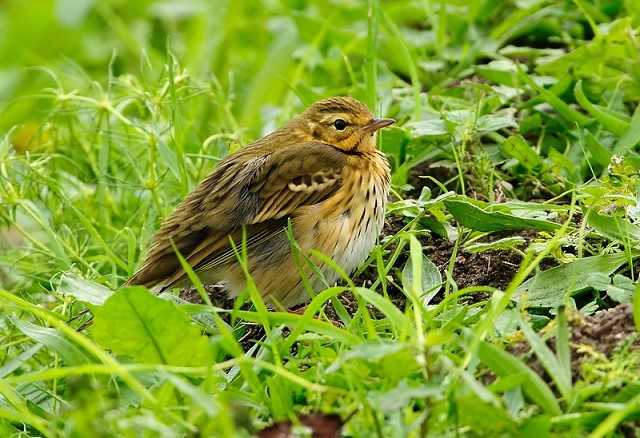
Olive-backed Pipit, St. Mary's, Isles of Scilly (Photo: Dave Perrett)

Olive-backed Pipit, Lowestoft, Suffolk (Photo: Chris Darby)
Olive-backed Pipits, St Mary's, Isle of Scilly (benjim1)
Apart from one at Quendale (Shetland) on 16th, all the week's Red-backed Shrikes were south of Spurn (East Yorks), where one was present on 16th. Others were in East Sussex, Scilly and Pembrokeshire, and two were in Cork, at Cape Clear and Mizen Head. The real news was of Great Grey Shrikes, though, with birds dropping into a large number of sites this week. There were a small number on the Northern Isles, but most arrived along the east coast from Borders to Kent, with a real cluster of records in East Anglia, including two at Corton (Suffolk) on 13th. Several birds made it straight to inland sites, in South Yorkshire, Leicestershire, Northamptonshire, Suffolk, Oxfordshire and Surrey. The furthest west were at Crowcombe (Somerset) on 16th–17th and Smeatharpe (Devon) on 19th. Both of last week's juvenile Woodchat Shrikes remained, at Lowestoft (Suffolk) to 14th and Galley Head (Cork) to 18th. The adult female Daurian Shrike remained at Hillwell (Shetland) to 17th and there were two new birds: a stunning adult male at Cliffe Pools (Kent) on 16th–17th and one at Dunwich Heath (Suffolk) in the late afternoon on 14th. This is just the second record for Suffolk, following one at Boyton Marshes in November 1997.

Great Grey Shrike, Kessingland, Suffolk (Photo: Chris Darby)
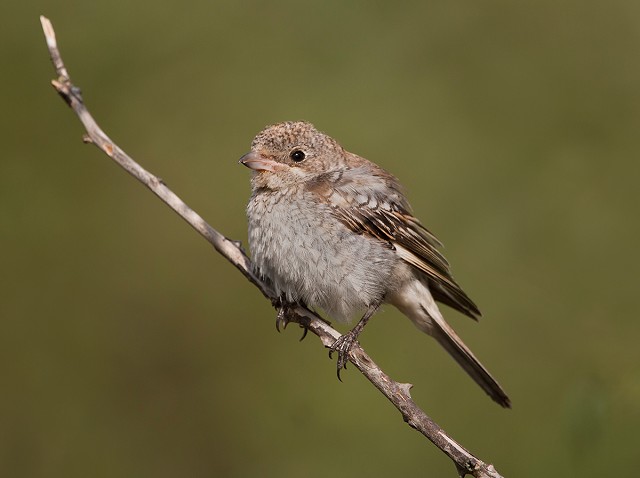
Woodchat Shrike, Lowestoft, Suffolk (Photo: Kevin Du Rose)
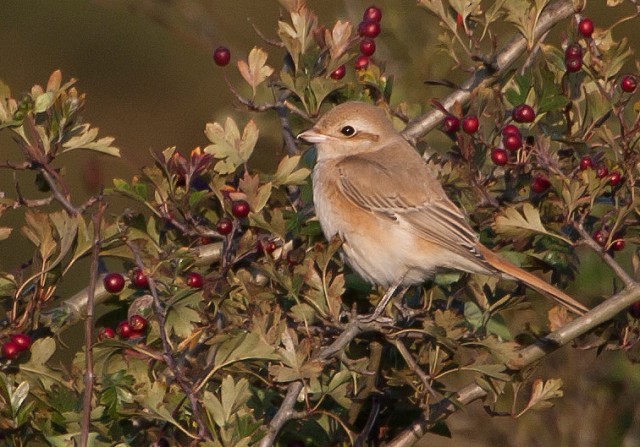
Isabelline Shrike, Dunwich Heath NT, Suffolk (Photo: Kevin Du Rose)

Isabelline Shrike, Cliffe Pools RSPB, Kent (Photo: Jonathan Theobald)
Woodchat Shrike, Lowestoft, Suffolk (garybirder)
The now annual autumn rush of Red-flanked Bluetails finally happened this week. One was on Papa Westray (Orkney) on 14th–15th and others were at seven sites along the east coast from Kent to Durham, where two were ringed at Whitburn on the morning of 13th, with one remaining to 19th. There were also two ringed at Flamborough Head (East Yorkshire), on 13th and 16th. Birds are still incredibly rare in the west and one on Hilbre Island (Cheshire) on 16th was the first county record. Rather surprisingly for such an obvious bird, of the 11 birds this week no fewer than eight were first discovered when trapped and ringed. On Scilly, two Bluethroats were on St Agnes and another on St Mary's, and elsewhere birds were at Stiffkey (Norfolk) on 15th, on the Farne Islands (Northumberland) on 15th–16th and reported at Durlston Country Park (Dorset) on 14th.

Red-flanked Bluetail, Minsmere RSPB, Suffolk (Photo: Jon Evans)

Bluethroat, St. Mary's, Isles of Scilly (Photo: Martin Goodey)
The only new Nearctic passerines that survived long enough to be twitched were in Co Cork: a Grey-cheeked Thrush was on Dursey Island on 14th–15th and Red-eyed Vireos were on Cape Clear on 14th–15th and on Mizen Head on 19th.

Red-eyed Vireo, Cape Clear, Cork (Photo: Derek Charles)
On Fair Isle, arrivals from the east included the year's first Lanceolated Warbler on 13th, with one found dead the next day thought to be a different bird. The 14th also saw a Blyth's Reed Warbler on the island and another was at the opposite end of the country, on St Mary's (Scilly) on 16th; a probable was also at Stiffkey (Norfolk) on 17th. A Booted Warbler at Landguard (Suffolk) on 16th was just the second for the county, following one at Gorleston-on-Sea in September 1996. In County Cork, Melodious Warblers were reported from Knockadoon Head and Three Castles Head on 15th, and another was on St Mary's (Scilly) on 16th–17th.
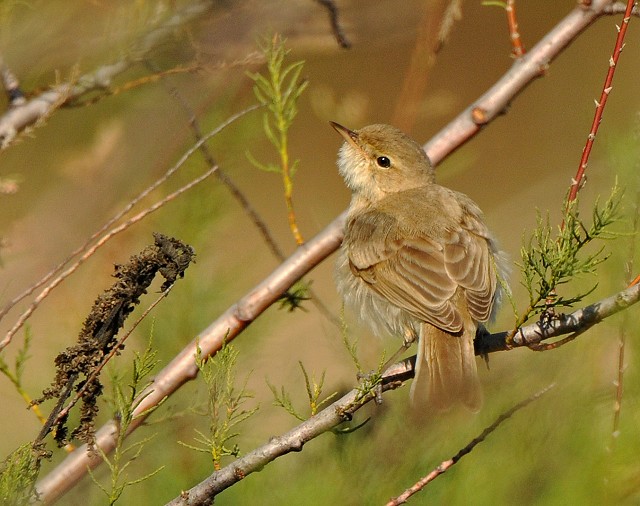
Booted Warbler, Landguard NR, Suffolk (Photo: Jon Evans)
The week's easterlies also brought the year's first Dusky and Radde's Warblers. The first Dusky was at The Naze (Essex) on 14th, followed by birds on Foula (Shetland) and at Reculver (Kent) on 15th. The first Radde's was at Waxham (Norfolk) on 14th, followed by birds at Out Newton (East Yorks) on 14th, St Mary's (Scilly) on 15th–18th and one ringed at Weybourne (Norfolk) on 15th, staying to 17th. Following last week's "probable", seven more Pallas's Warblers arrived this week: two in Shetland, two in Kent and singles in Orkney, Anglesey and Essex. As for Yellow-browed Warblers, very large numbers of birds arrived along the entire east coast from Aberdeenshire to Kent, with plenty of scattered records along the south and west coasts. The only coastal areas missing out were southeast Scotland, the Isle of Man and Ireland away from the south coast. The only truly inland bird, though, was at Knapwell (Cambs) on the morning of 18th. Many coastal sites held multiple birds and it was often difficult to judge numbers of birds present. The peak count was an impressive 16 at Flamborough Head (East Yorks) on 15th, and there were up to five at Saltburn (Cleveland), five at Mire Loch (Borders), four at Spurn (East Yorks), four on Hartlepool Headland (Cleveland) and three at numerous sites.
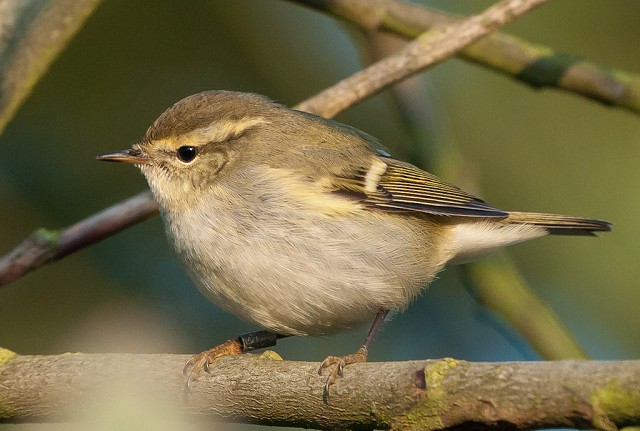
Yellow-browed Warbler, Kilnsea, East Yorkshire (Photo: Martin Standley)

Yellow-browed Warbler, St. Mary's, Isles of Scilly (Photo: Martin Goodey)
Barred Warblers were well scattered across the country at as many as 12 sites, including one inland bird ringed at Grimley (Worcs) on 16th (the first record for the county and first in the West Midlands area since 1979). The female Subalpine Warbler remained on St Mary's (Scilly) to 16th and an unidentified Bonelli's Warbler sp. was also on the island on 17th. There was another Central Asian Lesser Whitethroat, this time on Blakeney Point (Norfolk) on 19th. Another interesting possible was a probable Hume's Leaf Warbler, the first of the year, at Warham Greens (Norfolk) on 15th. Once again Scilly produced most of the week's Siberian Chiffchaffs: one an St Agnes on 19th and a possible on St Mary's to 15th. Other possibles were reported from Great Orme (Conwy) on 16th and Gunton (Suffolk) on 17th.

Barred Warbler, Bardsey Island, Gwynedd (Photo: Richard Brown)

Subalpine Warbler, St. Mary's, Isles of Scilly (Photo: David H Hatton)
A small arrival of Red-breasted Flycatchers in the south included birds at Gibraltar Point (Lincs) on 13th, Garinish Point (Cark) on 4th, Skomer (Pembrokeshire) on 15th and Porthgwarra (Cornwall) on 16th, while others remained on St Agnes (Scilly) to 14th and Barra (Outer Hebrides) to 15th. There were also two on Cape Clear (Cork) on 14th–15th. Unusual arrivals included a Penduline Tit at Dungeness (Kent) on 15th and a Rustic Bunting reported at Flamborough Head (East Yorks) on 14th. The only Little Bunting of the week was one on Orford Ness (Suffolk) on 13th. There were rather fewer Lapland Buntings this week than last, with no double-figure counts, and once again the vast majority were coastal. The only inland bird was at Rainham Marshes (London) on 15th.

Red-breasted Flycatcher, Cape Clear, Cork (Photo: Paul & Andrea Kelly)
In contrast to last week, most of this week's Common Rosefinches were on Scilly and in County Cork: on St Mary's and Bryher (Scilly) and on Dursey Island, at Mizen Head and at Barley Cove (Cork). The only outlier was one on Lundy (Devon) on 13th. An interesting probable was a Parrot Crossbill at Sandwich Bay (Kent) on 16th. Numerous Rose-coloured Starlings arrived during the week, mostly in the south and west. Birds were present at 15 sites, with the extremes being birds at Nefyn (Gwynedd) on 19th, on Dursey Island (Cork) on 14th–15th and a possible at Saltdean (East Sussex) on 17th. There was also a rather unusual record of three together on Cape Clear (Cork) on 15th.
Photo of the Week: 13th–19th October

Red-flanked Bluetail, Minsmere RSPB, Suffolk (Photo: Kit Day)
Bird photographer Kit Day won his first Photo of the Week way back in 2004, only ten weeks after our PotW award was first introduced. Since then, despite still only being in his mid-twenties, he has built up an impressive collection of bird images from home and abroad. Many of Kit's photos from the UK are of rarities, and this week he caught up with the Red-flanked Bluetail that briefly visited Minsmere in Suffolk. Even with rarities, though, Kit manages to get the kinds of images most photographers would love to capture of common species. In the case of this week's Bluetail, he has captured a sharp, colourful, nicely framed image that just makes you wish you were there. Most of the time, bird photographers aim to capture birds looking towards the camera, or at least sideways-on. With this image, though, Kit shows that a turned-away pose can also sometimes work, suggesting a totally undisturbed bird and leading the viewer to wonder exactly what it has seen.
Other notable photos

Merlin, Dungeness, Kent (Photo: Mick Southcott)

Bluethroat, St. Mary's, Isles of Scilly (Photo: Dave Perrett)

Long-eared Owl, Minsmere RSPB, Suffolk (Photo: Chris Darby)

Pomarine Skua, Cleveleys, Lancashire (Photo: David Moreton)

Woodchat Shrike, Lowestoft, Suffolk (Photo: Garth Peacock)

Black-tailed Godwit, Cley Marshes NWT, Norfolk (Photo: Tom Hines)
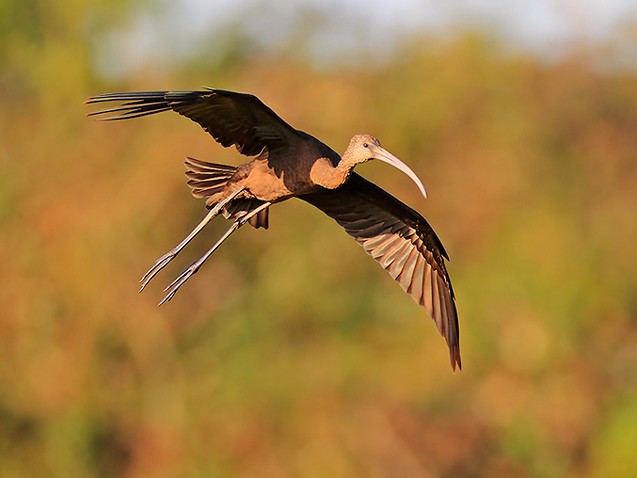
Glossy Ibis, Stanpit Marsh, Dorset (Photo: Nigel Forrow)

Pied Kingfisher, Kenya (Photo: Austin Thomas)

Hoopoe, Dubai (Photo: Jamie MacArthur)

Purple Heron, Hungary (Photo: Eduardo Balogh)

Northern Wheatear, Newhaven, East Sussex (Photo: John Stanton)

Greenshank, Lodmoor RSPB, Dorset (Photo: Kev Joynes)

